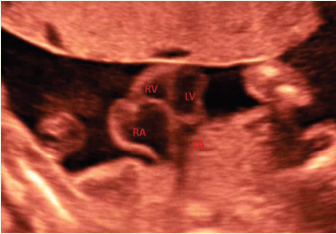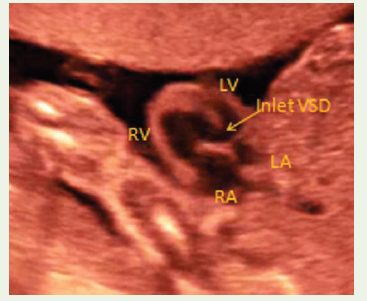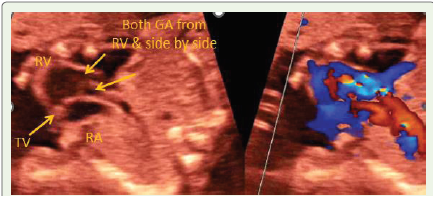Case Report
Antenatal Diagnosis of a Case of Ectopia Cordis with Complex Congenital Heart Defects in a Resource Limited Set Up in a Remote Part of Eastern India
Islam N1 and Saha S1*
Department of Pediatric Cardiology, Senior consultant, Health world hospitals, Durgapur, West Bengal, India
*Corresponding author:Siddhartha Saha, Department of Pediatric Cardiology, Health world hospitals, Durgapur, West Bengal, India. E-mail Id: drsiddharthasahasskm@gmail.com
Copyright: ©2024 Islam N, et al. This is an open access article distributed under the Creative Commons Attribution License, which permits unrestricted use, distribution, and reproduction in any medium, provided the original work is properly cited.
Article Information:Submission: 01/06/2024; Accepted: 08/07/2024; Published: 20/07/2024
Abstract
Ectopic cordis is a rare congenital anomaly. Here, the fetal heart is displaced outside the thoracic cavity partially or completely. We describe a case of antenatal diagnosis of Thoracic Ectopia Cordis (EC) with congenital heart disease (CHD) without any other extracardiac malformations. Fetal Echocardiographic examination showed large VSD, double outlet right ventricle and unrestricted pulmonary and systemic blood flow. The diagnosis of Ectopia cordis and associated cardiac and non-cardiac anomalies may be difficult in the fetal period due to multiple factors, so meticulous attention should be paid for proper diagnosis.
Introduction
Ectopia cordis (EC) is a rare congenital anomaly with an
incidence of 5.5 to 7.9 per one million live birth. In this condition,
the foetal heart is projected outside the thoracic cavity either partially
or completely. It contributes around 0.1% to congenital heart disease
(CHD). Infants with EC usually have a poor prognosis. Factors
affecting prognosis include type of EC and severity of other cardiac
and extracardiac congenital anomalies. [1,2]. It affects all races
equally with male preponderance [3,4].
Most newborns (90%) with EC are born with CHD. The most
frequent being ventricular septal defect (VSD) in 59% of cases. Other
anomalies include pulmonary atresia or stenosis, atrial septal defect,
tetralogy of Fallot, right ventricular diverticulum, double outlet right
ventricle (DORV), complete transposition of great arteries, and rarely
atrioventricular septal defect. [4]
The EC may be associated with other midline defects called the
Pentalogy of Cantrell syndrome. This syndrome consists of thoracoabdominal
EC, anterior diaphragmatic hernia, lower sternal defect,
midline supra-umbilical defect (omphalocele) with associated
pericardial and intra-cardiac defects. [5,6] Ectopia cordis may also
be accompanied with few extracardiac anomalies like amniotic band
syndrome, cleft lip and palate, omphalocele, diaphragmatic hernia,
body stalk syndrome and skeletal malformations such as kyphosis.
[7] Normal karyotype is most often reported in screened patients,
however, abnormal karyotypes like XXY, trisomy 18 and trisomy 21
and Turner syndrome are also been reported. [4,8]
Case Report
A 22-year-old woman (Gravida3, para 2) was referred for
fetal echocardiographic evaluation at 22nd weeks of gestation. The
pregnancy was spontaneous. She had regular prenatal care including
folic acid supplementation after pregnancy confirmation. There was
history of two abortions, but no family history of congenital heart
disease, genetic disorders or any anomaly related to ectopia cordis.
There was also no history of exposure to radiation, teratogenic drugs,
toxins or any physical trauma. Routine sonography and anomaly
scan at 20th weeks of gestation revealed thoracic ectopia cordis.
Diagnosis of cardiac defects associated with EC was made by fetal
echocardiography. It showed complete thoracic EC, large malalinged
VSD, double outlet right ventricle i.e. both the great arteries arising
from right ventricle (anterior ventricle with an AV valve placed more
apically) with aortic override, unobstructed pulmonary and systemic
outflow, disproportionately dilated right atrium and ventricle with a
large patent foramen ovale. (Figure 1-3) Parents were explained in
details about the anomalies, multi staged treatment plans and possible
outcome. After detailed discussion with obstetrician, parents opted
for abortion of the foetus, but they did not agree to do any genetic
testing and autopsy of the abortus. We have taken written consent
from the patient before publishing this case.
Discussion
There are several theories about the genesis of ectopia cordis but
none of them are fully proven. Most of the theories state that lateral
body folds cannot descend appropriately and midline fusion doesn’t
occur. Also, premature rupture of the chorion and/or yolk sac leads to
failure of midline fusion at around 3rd week of gestation. [2,8,9]It has
been stated that Bone Morphogenetic Protein 2 gene (BMP2) knock
out (KO) defects cause impairment in Ventral Folding Morphogenesis
(VFM) resulting in extra thoracic displacement of the heart. [4] The
complexity and severity of associated cardiac disorders determine the
prognosis of EC. [10]Here the heart lost its protection by the sternum
and predisposed to direct trauma. Another complication is frequent
chest infections due to the paradoxical movement of the lungs. [4,8]
This anomaly results in stillbirth or death in the early neonatal period
in most cases. [7]
Given the high mortality rate of EC, therapeutic abortion prior to
the age of viability may be considered in most cases. [10] In our case,
therapeutic abortion before viability was chosen by the parents. The
combination of fetal MRI and fetal echocardiography are often used
for follow-up of these cases if pregnancy is continued. [6]
In a study on seven fetuses with ectopic cordis (out of six
pregnancies), abdominal wall defects were detected in six fetuses.
Other abnormalities were kyphoscoliosis, encephalocele, clubfoot
and short umbilical cord. Five pregnancies were terminated, one died
in utero, and others died on the second day of life. This emphasized
the poor outcome of EC. [11]
A major difficulty of performing foetal echocardiography in EC is
the poor echo window resulting from cardiac malposition, squeezing
of heart by chest wall ostium and hypermobility due to lack of
supporting adjacent structures. This makes the actual diagnosis more
difficult. [6]
Conclusion
The awareness among obstetricians and parents about the utility
of doing timely fetal echocardiography is increasing nowadays, even
in the remote parts of eastern India. As a result, complex congenital
heart defects are diagnosed before reaching viability. As a result,
parents can get time to take the decision regarding the continuation of
pregnancy after getting informed about the disease and its prognosis
in detail.



